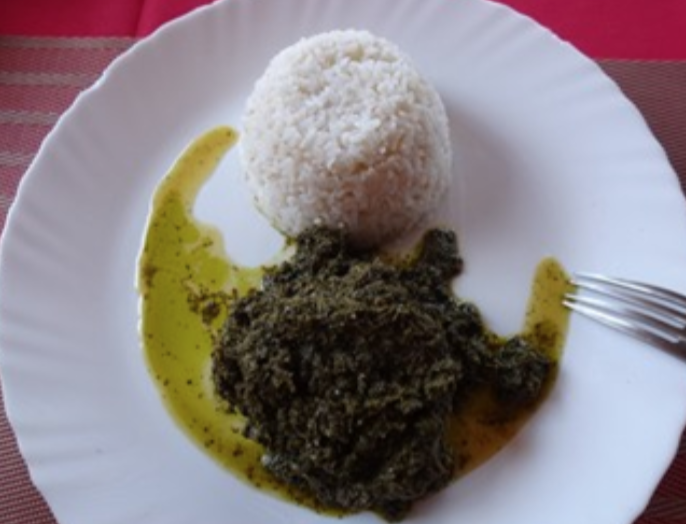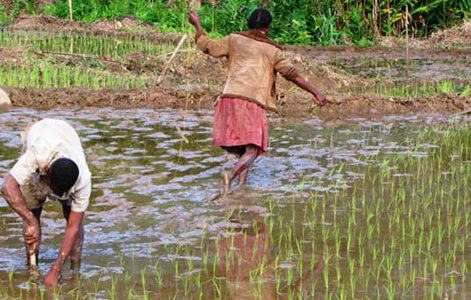By Bethany Old
Master’s candidate, Sanford School of Public Policy, Duke University
Madagascar has the fourth-highest rate of chronic malnutrition in the world (The World Bank, 2018). The country is rich in fruits, vegetables, and legume diversity but nutrition education remains critically low. I served in the education sector of Peace Corps Madagascar from 2015-2018 in the northwest Diana region. My site was in a rural rice and sugar cane farming village, called Ampondralava, which means “the fertile land.” I had a unique immersion into this village and the cultural and dietary habits of Malagasy people. Peace Corps volunteers were trained to look for signs of malnutrition in young children’s hair by the orange hue in the roots. I would often see orange tones in babies’ and toddlers’ hair and feel compelled to take a more active role in nutrition development after being witness to its damaging effects.
The main staple in Madagascar is white rice, which is the foundation for breakfast, lunch, and dinner. White rice, unfortunately, is not rich in nutrients. Rice is so engrained into Malagasy food culture that the mentality is: if a Malagasy person skips rice as a meal, they will not be able to sleep well at night. Developing the comprehensiveness of nutrition while respecting cultural norms will be challenging with white rice being so highly regarded and necessary for the Malagasy belly and spirit to be filled. The breakdown of nutrition education coupled with extreme poverty, as 80% of Malagasy people live off 1.90$ a day, are critical barriers (Victoria & Granchamp, 2019). Generally, Malagasy people remain uninformed on healthy eating and are economically unable to afford costly vegetables and fruits to mitigate the lasting effects of chronic malnutrition (Victoria & Granchamp, 2019). Moringa patiently waits to fill this gap.

A common dish in Madagascar is rice and ground cassava leaves (ravitoto). While these green leaves are nutritious, they do not provide the full complement of nutrients needed for healthy diets.
Moringa is a local tree that holds nutritious leaves and stems that Malagasy often cook in a broth served with rice. Moringa leaves are readily available, which could explain the lower status stigma attached to its consumption and use. By comparison, meat has a positive status symbol. Vegetables are lackluster accompaniments, and this shows in their rare appearances in Malagasy meals (Nestorine, Andriantinefiarijaona, Esperio, & Herrera, 2021).
Between 40-60% of Malagasy children are affected by malnutrition resulting in stunting, anemia, and being underweight (Andriamparany, Hänke, & Schlecht, 2021). When children are stunted, they have less energy and proper health to attend school regularly negatively impacting their educational attainment. The issue of malnutrition carries into adulthood adversely affecting health and prosperity for Malagasy. The south of Madagascar receives global attention due to its desert and dry environment making crop growth especially difficult leading to more visual signs of food insecurity. In comparison, the SAVA (Sambava, Andapa, Vohemar, Antalaha) region in the northeast receives less global attention but suffers from chronic malnutrition with less aid support (Andriamparany, Hänke, & Schlecht, 2021).

Rice cultivation has many forms. In many areas, slash/burn agriculture have decimated lemur habitat, another reason to diversify diets. Photo by Nancy Raposa.
During the lean months, food prices are higher and local farmers rarely stock food or rice as production is scarce (Andriamparany, Hänke, & Schlecht, 2021). Agriculture is an area of concern with low productivity agricultural practices and degraded soil due to deforestation (Nestorine, Andriantinefiarijaona, Esperio, & Herrera, 2021). However, agriculture can also be an area of opportunity through individual home gardens to regenerative agriculture techniques to improve self-sufficiency and food security.

Nestorine leads workshops about balanced, healthy diets, especially focused on including diverse food groups and fruits and vegetables of many colors.
Nestorine is a Malagasy woman with her Master’s degree in Biochemistry, Microbiology, and Applied Biotechnology working in the SAVA region of Madagascar to alleviate the problem of malnutrition using the local “miracle tree”: moringa. Nestorine and her team are conducting 24-hour recall surveys in SAVA households to glean dietary habits and diversity. These surveys work to quantify the lack of high food diversity and find possible gaps in nutrition by introducing a supplement made from local ingredients into households (Nestorine, 2021). She has also created a network of trained and educated mothers who are knowledgeable about balanced and healthy diets. They act as trainers for their villages to spread more awareness about nutrition using local and seasonal food groups. (Read some of the preliminary results of these surveys here!)
Nestorine has created a powder made from moringa leaves, cassava flour, peanut paste, and local fruits. Moringa has 10 times more vitamin A than carrots, 7 times more vitamin C than oranges, 9 times more protein than yogurt, 25 times more iron than spinach, 17 times more calcium than milk, 15 times more potassium than bananas (Gopalakrishnan, Doriya, & Kumar, 2016). This local remedy could be part of the solution to chronic malnutrition in the SAVA region and then scaled up in Madagascar nationally. Presently, Nestorine is working with her research assistant to try different combinations of jackfruit, banana, and lichis powder to add to the moringa base for testing variations for the nutrition analysis in Antananarivo. The nutrient dosage of the powder is still unknown as the analysis lab is located 800 miles south in the capital, Antananarivo.
I have an opportunity to work with a Bass Connections team in SAVA Madagascar through the Duke Lemur Center. I am motivated to work with Nestorine to collect more data and develop solutions through participatory methods and develop these findings into my Master’s thesis. My goal is to develop my own survey and assist in the process of discovery, development, and delivery of a local moringa-based nutrition supplement. Pilot sites would need to be selected with help from key stakeholders like the Office of Regional Nutrition in Sambava, while technical assistance could be encouraged through the CURSA university in SAVA.
Chronic malnutrition significantly affects Malagasy’s growth and development potential. Using local sources to form a solution to malnutrition would ensure sustainability and longevity of the continued use of the moringa powder. It will be necessary to highlight what is technically feasible to implement while also balancing financial viability as Madagascar is impoverished and infrastructure is lacking. As the Malagasy say, paré zegny allô atsika (alright then, let’s go).

